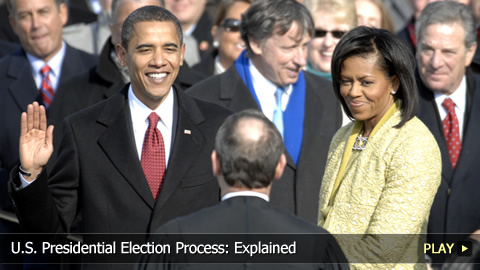U.S. Presidential Election Process: Explained

Who can vote?
In general, every U.S. citizen aged 18 and over can vote in a presidential election, as long as they have registered to do so.
Who can run?
Presidential candidates must be at least 35-years-old, must have been a permanent U.S. resident for at least 14 years, and must be considered a natural-born U.S. citizen. No one can be elected President more than twice. Those convicted of impeachment and those who have rebelled against the Constitution are also not eligible barring congressional intervention.
What are the primaries and the caucuses?
Primaries and caucuses are where the Presidential candidates for the two main political parties are chosen. They occur between January and June of election year. Some states use only primaries, others use only caucuses, and some use both. These systems are quite different.
Primaries are government-run, and are decided by secret ballot. There are two kinds of primaries: in a closed primary, you can only vote for a candidate in your political party. In an open primary, you can vote for the candidate in any party. New Hampshire is one state that uses the primary system.
Caucuses are organized by the parties themselves. Party members meet and break into groups based on which candidate they support, and try to sway undecided voters to support their candidate. At the end, whoever has the most supporters at the caucus wins. Iowa and Texas are examples of two states that hold caucuses.
What is the National Convention?
The National Convention is the event at which each party’s nominees for President and Vice President are officially announced, and their platforms are discussed. Today, it is mainly a big pep rally for the two parties. The chosen candidates then campaign by traveling the country to meet the public and give speeches. They also participate in televised debates leading to Election Day.
What happens on Election Day?
Eligible voters head to the polls to cast their ballots. However, instead of voting directly for President and Vice President, the popular vote chooses members of the Electoral College.
What is the Electoral College?
The Electoral College is the group that officially elects the President and Vice President. Candidates for the Electoral College are nominated by the political parties, and voted on by the public on Election Day. This is called an indirect vote.
Each state is assigned a number of electors based on how many Senators and Representatives it has in Congress. The exact number of electors for each state is decided every ten years based on the results of the U.S. Census.
Most states use the winner-takes-all method, which means that if a candidate wins the majority of votes in his or her state, that candidate will win all of that state’s electoral seats. However, in some states, the votes can be split among multiple candidates based on the proportion of votes they receive. This is called the Congressional District Method.
The Electoral College system was chosen as a compromise between those who wanted Congress to elect the President, and those who wished it to be done by popular vote.
How does someone win the election?
Someone wins the election by earning an absolute majority of Electoral College votes.
The Electoral College members chosen by the public on Election Day meet on the Monday after the second Wednesday in December in their state’s capital to cast ballots for President and Vice President. On January 6th the following year, the winner of that vote is announced. If no candidate earns a majority of Electoral College votes, the decision is made by the House of Representatives. This has happened twice in U.S. history: once in 1800 when Thomas Jefferson was elected, next in 1824 when John Quincy Adams took office.
In most cases, the Electoral College and the population choose the same candidate for President. However, a famous case where the popular vote and the Electoral College results did not match was the 2000 Election between George W. Bush and Al Gore: while Gore received more popular votes, Bush earned more electoral votes and thus won the presidency.
Once the candidate is officially announced, he or she is inaugurated President on January 20th, and serves the next four years in the White House.

